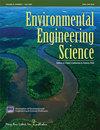Process-Based Model to Describe Treatment of Nitrate-Rich Groundwater Using Emulsified Oil
IF 1.8
4区 环境科学与生态学
Q4 ENGINEERING, ENVIRONMENTAL
引用次数: 1
Abstract
Permeable reactive barriers (PRBs) are being considered for treatment where the discharge of nitrate plumes contributes to eutrophication (e.g., Cape Cod, MA). PRBs enhance denitrification through the addition of carbon-based amendments such as the injection of emulsified vegetable oil (EVO). The use of EVO to stimulate denitrification foregrounds aspects of carbon utilization, dosing, longevity, and secondary effects in ways that differ from the application of EVO at hazardous waste sites. The overall objective of this study was to develop and evaluate a process-based modeling approach for simulating denitrification stimulated and supported by EVO. A series of one-dimensional column experiments assessed emulsion retention, production of soluble substrate, and utilization of carbon for nitrate reduction. Retention of 5.5 g dispersed phase emulsion resulted in sustained reduction of nitrate (∼43 mg/day) at ∼2 m/day porewater velocity. Biokinetic processes underlying the model are based on the two-step denitrification description of the Activated Sludge Model (ASM) No. 3. Biokinetic processes were integrated within the flow and transport simulator COMSOL to simulate the column experiment. The model capitalizes on the biokinetic parameters available in the ASM literature to limit the number of site-specific fits of model parameters. Simulation results demonstrate how this approach can result in reasonable predictions, although model performance was enhanced by fitting two parameters—yield coefficients for nitrate and nitrite. Comparisons with existing biokinetic transport models that were similarly fit to the column data suggest that the better overall descriptions of the column data using the process-based model stem from a more robust handling of spatial and temporal distribution of biomass. Sensitivity analyses highlight the importance of accurately describing the transformation of complex carbon into soluble substrate, and the subsequent utilization of that substrate. This research establishes a foundation for exploring implications of carbon processing on dosing, longevity, and effectiveness in denitrifying PRBs.基于过程的模型描述乳化油处理富硝酸盐地下水
可渗透反应性屏障(PRBs)正在考虑用于处理硝酸盐羽流排放导致富营养化的地方(例如,马萨诸塞州科德角)。PRBs通过添加碳基改性剂(如注入乳化植物油(EVO))来增强反硝化作用。使用EVO刺激反硝化的前景是碳利用、剂量、寿命和次生效应等方面,其方式不同于在危险废物场所应用EVO。本研究的总体目标是开发和评估一种基于过程的建模方法,用于模拟EVO刺激和支持的反硝化。一系列一维柱实验评估了乳状液的保留、可溶性底物的产生以及碳对硝酸盐还原的利用。5.5 g分散相乳液的保留导致硝酸盐以2 m/天的孔隙水速度持续减少(~ 43 mg/天)。该模型的生物动力学过程基于活性污泥模型(ASM) No. 3的两步反硝化描述。在流动和输送模拟器COMSOL中集成了生物动力学过程来模拟柱实验。该模型利用ASM文献中可用的生物动力学参数来限制模型参数的特定位置拟合的数量。模拟结果表明,尽管通过拟合两个参数——硝酸盐和亚硝酸盐的产率系数,模型性能得到了提高,但这种方法可以得出合理的预测。与同样适合柱数据的现有生物动力学传输模型的比较表明,使用基于过程的模型对柱数据的更好的总体描述源于对生物量时空分布的更稳健的处理。敏感性分析强调了准确描述复杂碳转化为可溶性底物的重要性,以及该底物的后续利用。本研究为探索碳处理对PRBs反硝化投加量、寿命和有效性的影响奠定了基础。
本文章由计算机程序翻译,如有差异,请以英文原文为准。
求助全文
约1分钟内获得全文
求助全文
来源期刊

Environmental Engineering Science
环境科学-工程:环境
CiteScore
3.90
自引率
5.60%
发文量
67
审稿时长
4.9 months
期刊介绍:
Environmental Engineering Science explores innovative solutions to problems in air, water, and land contamination and waste disposal, with coverage of climate change, environmental risk assessment and management, green technologies, sustainability, and environmental policy. Published monthly online, the Journal features applications of environmental engineering and scientific discoveries, policy issues, environmental economics, and sustainable development.
 求助内容:
求助内容: 应助结果提醒方式:
应助结果提醒方式:


